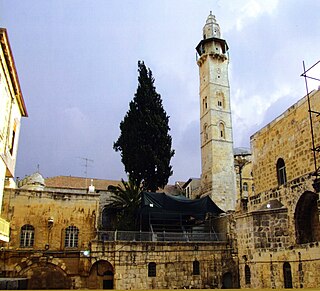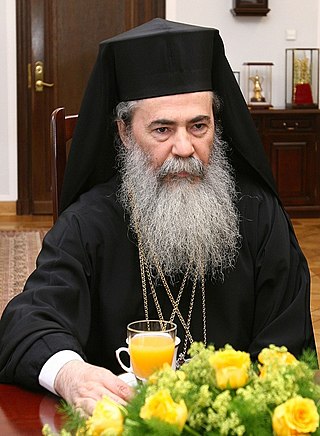Related Research Articles

The Church of the Holy Sepulchre, also known as the Church of the Resurrection, Arabic: كنيسة القيامة, romanized: Kanīsat al-Qiyāma. is a fourth-century church in the Christian Quarter of the Old City of Jerusalem. It is considered to be the holiest site for Christians in the world, as it has been the most important pilgrimage site for Christianity since the fourth century.

The Ayyubid Mosque of Omar is an Islamic place of worship inside the Old City of Jerusalem. It is located opposite the southern courtyard of the Church of the Holy Sepulchre, in the Muristan area of the Christian Quarter. The mosque is not open to tourists, and can be accessed only for praying.

The Latin Patriarchate of Jerusalem is the Latin Catholic ecclesiastical patriarchate in Jerusalem, officially seated in the Church of the Holy Sepulchre. It was originally established in 1099, with the Kingdom of Jerusalem encompassing the territories in the Holy Land newly conquered by the First Crusade. From 1374 to 1847 it was a titular see, with the patriarchs of Jerusalem being based at the Basilica di San Lorenzo fuori le Mura in Rome. Pope Pius IX re-established a resident Latin patriarch in 1847.

The Greek Orthodox patriarch of Jerusalem or Eastern Orthodox patriarch of Jerusalem, officially patriarch of Jerusalem, is the head bishop of the Greek Orthodox Patriarchate of Jerusalem, ranking fourth of nine patriarchs in the Eastern Orthodox Church. Since 2005, the Eastern Orthodox patriarch of Jerusalem has been Theophilos III. The patriarch is styled "Patriarch of the Holy City of Jerusalem and all Holy Land, Syria, beyond the Jordan River, Cana of Galilee, and Holy Zion." The patriarch is the head of the Brotherhood of the Holy Sepulchre, and the religious leader of about 130,000 Eastern Orthodox Christians in the Holy Land, most of them Palestinians.

The Equestrian Order of the Holy Sepulchre of Jerusalem, also called Order of the Holy Sepulchre or Knights of the Holy Sepulchre, is a Catholic order of knighthood under the protection of the Holy See. The pope is the sovereign of the order. The order creates canons as well as knights, with the primary mission to "support the Christian presence in the Holy Land". It is an internationally recognized order of chivalry.

The Melkite Greek Catholic Church, or Melkite Byzantine Catholic Church, is an Eastern Catholic church in full communion with the Holy See as part of the worldwide Catholic Church. Its chief pastor is Patriarch Youssef Absi, headquartered at the Cathedral of Our Lady of the Dormition in Damascus, Syria. The Melkites, who are Byzantine Rite Catholics, trace their history to the early Christians of Antioch, formerly part of Syria and now in Turkey, of the 1st century AD, where Christianity was introduced by Saint Peter.

Gregory III Laham, B.S., Emeritus Patriarch of Antioch and All the East, of Alexandria and Jerusalem, is the former spiritual leader of the Melkite Greek Catholic Church. He was elected on November 29, 2000, succeeding Patriarch Maximos V Hakim. He retired on May 6, 2017.
Maximos IV Sayegh was Patriarch of Antioch and All the East, and Alexandria and Jerusalem of the Melkite Greek Catholic Church from 1947 until his death in 1967. One of the fathers of Second Vatican Council, the outspoken patriarch stirred the Council by urging reconciliation between the Catholic and Eastern Orthodox churches. He accepted the title of cardinal in 1965 after Pope Paul VI clarified the significance of that title in the case of an Eastern Patriarch.

The siege of Jerusalem (636–637) was part of the Muslim conquest of the Levant and the result of the military efforts of the Rashidun Caliphate against the Byzantine Empire in the year 636–637/38. It began when the Rashidun army, under the command of Abu Ubayda, besieged Jerusalem beginning in November 636. After six months, the Patriarch Sophronius agreed to surrender, on condition that he submit only to the Caliph. In 637 or 638, Caliph Umar traveled to Jerusalem in person to receive the submission of the city. The Patriarch thus surrendered to him.
Clement Michael Bahouth was patriarch of the Melkite Catholic Church from 1856 until his resignation in 1864.
John VII was Patriarch of Jerusalem from 964 to 966. He was among the bishops of Jerusalem who suffered a martyr's death at the hands of Muslim mobs. He was elected patriarch after the death of his predecessor Agathon in 964.

Patriarch Benedict of Jerusalem, also Benediktos I of Jerusalem, born Vasileios Papadopoulos was the Patriarch of Jerusalem of the Greek Orthodox Church of Jerusalem from 1957 to 1980.
Orestes Hieremias, also called Ariston, was the Melkite Patriarch of Jerusalem from 15 January 986 until his death on 3 February 1006.
Theophilus I of Jerusalem was the patriarch of the Church of Jerusalem from 1012 to 1020.

The Church of the Holy Sepulchre, churches, synagogues, Torah scrolls and other non-Muslim religious artifacts and buildings in and around Jerusalem, were destroyed starting on 28 September 1009 on the orders of the Fatimid Caliph Al-Hakim bi-Amr Allah, known by his critics as "the mad Caliph" or "Nero of Egypt". His son, the Fatimid Caliph Al-Zahir, allowed the Byzantines to rebuild the Church of the Holy Sepulchre in 1027–28. The construction of a much diminished ensemble was wrapped up by 1048. This was the second of the two times the church was seriously damaged, the first being in 614 during the Byzantine–Sasanian War of 602–628.

Hashemite custodianship refers to the Jordanian royal family's role in tending Muslim and Christian holy sites in the city of Jerusalem. The legacy traces back to 1924 when the Supreme Muslim Council, the highest Muslim body in charge of Muslim community affairs in Mandatory Palestine, chose Hussein bin Ali as custodian of Al-Aqsa. The custodianship became a Hashemite legacy administered by consecutive Jordanian kings.
Joseph II of Jerusalem was the patriarch of the Church of Jerusalem from 981 to 983. Little is known of his life. It was during his episcopate that Sadaqah Ibn Bishr, the Patriarchal syncellus, was able to complete the renovation of the Church of the Holy Sepulchre that had been damaged by fire during riots in 966.
Thomas I of Jerusalem, also known in Persian as Tamriq, was the Patriarch of Jerusalem of the Church of Jerusalem from 807 to 821. Patriarch Thomas held a firm Orthodox theological position and opposed both the iconoclasts and the filioque. He is considered a saint, commemorated in May 16.
Christodulus I of Jerusalem, also Christopher, was Melkite Patriarch of Jerusalem of the Church of Jerusalem from 937 to 951. Early in his patriarchate he was confronted with Muslim rioting and church destruction.
Christodulus of Jerusalem may refer to:
References
- ↑ Reynolds, Daniel, 'Death of a Patriarch: The Murder of Yūḥannā ibn Jamī (d. 966) and the Question of “Melkite” Identity in Early Islamic Palestine', in Rutger Kramer, and Walter Pohl (eds), Empires and Communities in the Post-Roman and Islamic World, C. 400-1000 CE (New York, 2021; online edn, Oxford Academic, 20 Jan. 2022), https://doi.org/10.1093/oso/9780190067946.003.0008,
- ↑ Jerusalem Patriarchate website, Apostolic Succession section